
A beginner’s recipe in cheese making!
In recent years I became fascinated with the idea of making my own cheese at home. At that time I started a journey to cut preservatives out of my diet, and basically re-taught myself new ways to cook my favorite recipes. I could go on for days about all the gross stuff you can find in prepackaged foods. Now don’t get me wrong, sometimes I do pick up a few items from the grocery store out of convenience but for the most part, I make a lot of our food from scratch. This new lifestyle allowed me to become a healthier version of myself and loosing over 100 lbs. That’s a story for another day, but trust me I know the downside of what preservatives can do to you.
Anyways back to the cheese! Farmer’s cheese is an unaged, mild white cheese. This cheese lends itself to being adjusted to a variety of flavors. I highly suggest chive farmer’s cheese! Everyone has their favorite recipe and this one is ours!
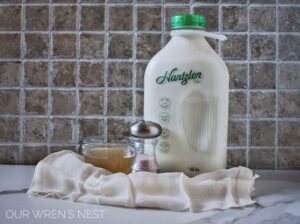
To make farmer’s cheese, you need to gather some ingredients. First, you need to find whole milk that has been minimally processed. If you use milk that has been ultra-pasteurized, this recipe won’t work correctly. Our milk of choice is for this recipe (among many other uses) is from Hartzler Dairy Farm. Their milk is processed using low-temperature vat pasteurization and is also non-homogenized. I was beyond elated to find their milk within the last few years, I could drink milk again, Yay! Not to mention the milk comes in glass containers and the cream on the top of the container is amazing.
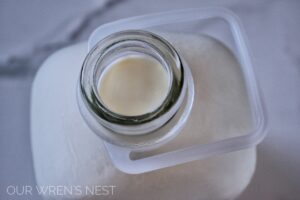
You will need acid to make your milk curdle, making the curds you will form into the cheese. You can use lemon juice, white vinegar, or even apple cider vinegar. I tend to use what I have around in the pantry on the day I make my cheese. Lately, I’ve been using apple cider vinegar with a mix of lemon juice. The last ingredients you will need to complete your farmer’s cheese are fresh herbs (we are using chives), and some salt to add to taste. Be sure to chop your herbs up very fine.

A large stockpot is needed for bringing your milk to the proper temperature and allowing your milk to curdle in. Make sure your pot is big enough to hold a gallon of milk, but also have some extra room. To drain the cheese, a piece of cheesecloth is needed. We prefer to use unbleached cheesecloth. After you have gathered all your ingredients, and supplies, it is time to get started
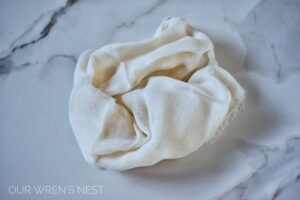
Start by pouring your milk into a stockpot, and turn your stove to low/medium heat. You want to heat your milk to a temperature of 190 degrees F. You want to do this low and slow so you do not scorch your milk. This can take a little time, so put on your favorite music in the kitchen, and enjoy a little break. Be sure to give the milk a stir throughout the warming and keep an eye on it while your jamming to your favorite tunes.
When the milk has reached 190 degrees F. now is time for the magic to happen. I like to turn off the stove and move my pot off the burner. While stirring the milk, pour in the acid you have chosen. Whichever type of acid you are using, you want to use a 1/4 cup. Keep gently stirring, and you should start to see something amazing happen. The curds will start to rise to the top of the pot, and you will see the whey at the bottom of your pot.
I like to let the mixture sit for about 10 minutes, stirring periodically. After 10 minutes, add your chopped herbs to the mixture. Let your mixture sit another 5 minutes or so. While your mixture is curdling, go ahead and line a strainer with a piece of cheesecloth. You will want to set your strainer in a bowl to collect the whey. Save the whey for use in other recipes, bread making is a great way to use up the whey!
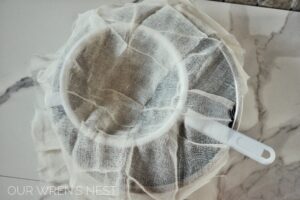
Carefully take your pot and strain your milk mixture. The curds will stay nicely in your cheesecloth, while the whey is collected in the bowl below.
Gather up your cheesecloth and give the curds a squeeze to get some of the whey out. Open the cheesecloth back up, and add salt to taste, working it through the semi-squished (is that a word?) curds. The cheese will still be very warm at this point so be careful when if sneak a small taste to make sure the salt is where you would like it.
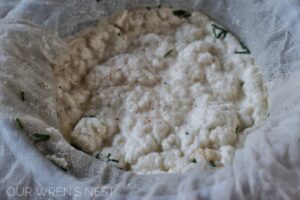
Gather the cheesecloth back up tightly. Twist just above your newly formed cheese, and tie off the cheesecloth with a piece of cotton string leaving some longer tails on your string. Next tie your “cheeseball” to a wooden, or anything that would allow your cheese to be suspended over a bowl for a little while. Place the cheese in the refrigerator for 1-2 hours. This will allow any extra whey to drain off, and form your newly make farmer’s cheese into a nice ball as well as allows your herbs to blend more into the cheese.
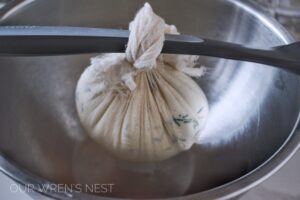
After the break in the fridge, take out your Farmer’s Cheese, gently unmold, and now it is time to enjoy! Farmer’s cheese is great on crackers, used in recipes, or wonderful just to eat alone. Farmer’s cheese will last up to a week in your fridge, but I guarantee, it won’t last that long!
This blog is not endorsed by any company’s noted in the article, we just love to share our favorites!
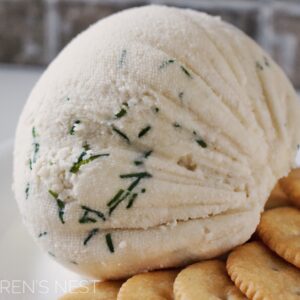
Homemade Farmer’s Cheese
Ingredients
- 1 gallon Whole Milk
- 1/4 cup White Vinegar, Apple Cider Vinegar, Lemon Juice (or a mix of)
- 1 ts Sea Salt
- 1-2 tbsp Fresh Herbs
Instructions
- Start by slowly warming up a gallon of whole milk, until it is 190 degrees F. in a large stock pot. Be careful to watch that you don't scorch your milk. Warm-up slowly
- After the milk has reached 190 degrees F., remove from heat and immediately add 1/4 cup of acid to the milk, and start to slowly stir. You should see your milk separate into curds and whey
- Allow the mixture to sit, stirring occasionally for 10 minutes. After 10 minutes, add your herbs to the stockpot. Gently stir and allow the mixture to set another 5 minutes
- Strain the milk through a strainer covered with cheesecloth. The curds will be captured in the cheesecloth. Be sure if you wish to save the whey (and you should!) put a bowl underneath when straining to capture the whey
- Gather your cheesecloth and give it a gentle squeeze to drain off the whey. Be careful, the curds will be very warm. Open up your cheesecloth and add salt to taste if you are going to add any. Gently work the salt through the curds
- Gather your cheesecloth once again, this time twisting the cheesecloth above the curds forming a cheese ball. Tie the ball with baker's twine, and hang over a bowl in the fridge for 2-3 hours to firm up
- After 2-3 hours, take your Farmer's Cheese out of the fridge, and unwrap from the cheesecloth. Enjoy your Farmer's Cheese with crackers and in your favorite recipes. Farmer's Cheese will last 1 week in the fridge (but it won't last that long, the Farmer's Cheese will get eaten very quickly!)
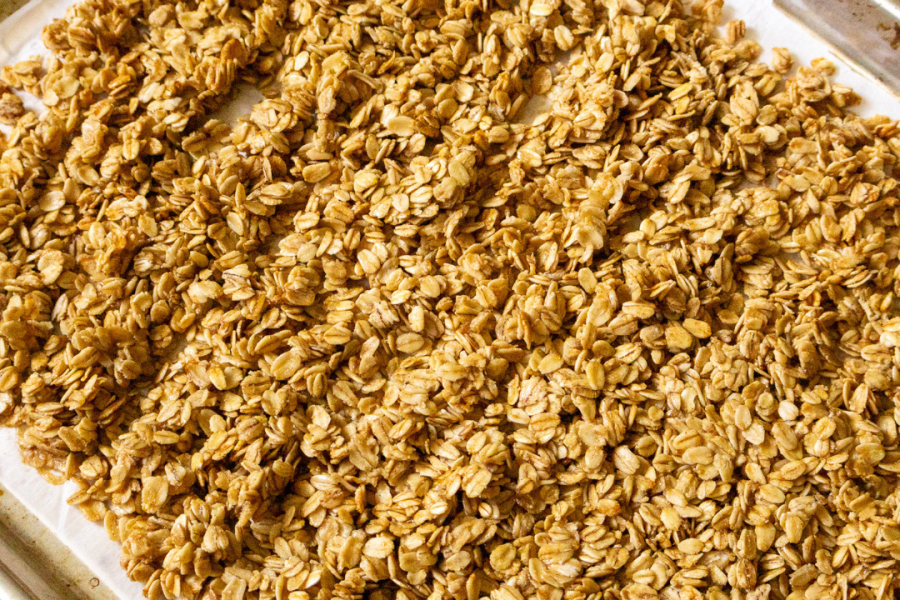


Mihaela | https://theworldisanoyster.com/ says
Love this! I make it often but simple. Next time I’ll add herbs, for sure! Thanks for the idea:)
OurWrensNest says
Great to hear! Thank you for visiting!